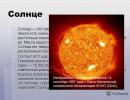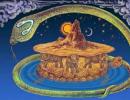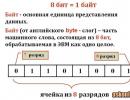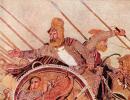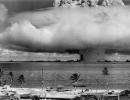Claude Shannon and his services to computer science. Who is Claude Shannon and why is he famous? Communication theory in secret systems
Claude Elwood Shannon - leading American scientist in the field of mathematics, engineering, cryptanalytics.
He gained worldwide fame thanks to his discoveries in the field of information technology and invention of the “bit” (1948), as the smallest information unit. He is considered the founder of information theory, the main provisions of which are still relevant in the section of high-tech communications and modern communications.
Shannon was also the concept of “entropy” was first introduced, which indicates an indefinite amount of transmitted information.
This scientist was the first to apply a scientific approach to information ideas and the laws of cryptography, substantiating his thoughts in works on the mathematical theory of communication, as well as on the theory of communication in secret systems.
He also made a great contribution to the development of cybernetics, substantiating such key points as the probabilistic scheme, the game scientific concept, as well as thoughts on creating automata and management systems.
Childhood and adolescence
Claude Shannon was born in Petoskey, Michigan, USA. This joyful event happened 04/30/1916.
The father of the future scientist was engaged in business in the field of advocacy, and then was appointed a judge. Mother taught foreign language and eventually received the position of school director in Gaylord.
Shannon Sr. had mathematical inclinations. A key role in shaping his grandson’s inclination towards scientific activity was played by his grandfather, a farmer and inventor.
In his arsenal creation of a washing machine and some types of applied agricultural machinery. It is noteworthy that Edison has family ties to this family.

At the age of 16, Claude graduated from high school, where his mother taught. I managed to work courier to Western Union, engaged in the design of various devices.
He was interested in modeling aircraft and radio equipment, and repairing small radio stations. With his own hands he made a radio-controlled boat and a telegraph for communicating with a friend.
As Claude himself assures, he was absolutely not interested only in politics and faith in God.
Student years
The University of Michigan opened its doors to Shannon in 1932. Studying here exposed him to the works of J. Boole. Claude received his bachelor's degree in mathematics and electrical engineering in 1936.
His first job was as a research assistant at the Massachusetts Institute of Technology. Claude conducted his scientific activities as an operator of a mechanical computer device created by his teacher V. Bush.
Having delved deeply into Boole's conceptual scientific developments, Shannon realized the possibility of their practical application. Protecting master's thesis in 1937, which was supervised by Frank L. Hitchcock, he moved to the famous Bell Telephone Laboratories, where he produced material on symbolic analysis in switching circuits and using relays.
It was published on the pages of a special magazine by the Institute of Electrical Engineers in the USA (1938).
The main provisions of the article were revealed improvement of telephone call routing, thanks to the replacement of electromechanical type relays with a switching circuit. The young scientist substantiated the concept of the possibility of solving all Boolean algebra problems using schemes.
This work by Shannon received Nobel Prize in Electrical Engineering (1940) and became the basis for creating logical digital circuits in electrical circuits. This master's work became a real scientific breakthrough of the twentieth century, laying the foundation for the creation of electronic computer technology of the modern generation.
Bush recommended that Shannon pursue a dissertation for a doctorate in mathematics. They paid serious attention to mathematical research in close connection with the genetic laws of inheritance of the famous Mendel. But this work never received due recognition and was first published only in 1993.
Scientists have devoted a lot of effort to building a mathematical foundation for various disciplines, especially information technology. This was facilitated by his communication with a prominent mathematician G. Weyl, as well as J. von Neumann, Einstein, Gödel.
War period
From the spring of 1941 to 1956 Claude Shannon works for US defense, developing fire control and enemy detection during air defense. He created a stable intergovernmental connection between the US President and the British Prime Minister.
He was awarded the National Research Award for his paper on the design of two-pole switching circuits (1942).
The scientist became interested in the ideas of the Englishman Turing on speech encryption (1943), and already in 1945 he published a work on data averaging and forecasting for fire control systems. Its co-authors were Ralph B. Blackman and H. Bode. Having modeled a special system that processes information and special signals, they ushered in the information age.
Secret memorandum of K. Shannon in the field mathematical theory of cryptography(1945) proved that cryptography and communication theory are inseparable.

Post-war period
This time was marked by his memorandum on the theory of communication from a mathematical point of view (1948) regarding the encoding of transmitted texts.
Shannon's subsequent work was closely related to information theory in the field of game development, in particular the roulette wheel, the mind-reading machine, and the on solving a Rubik's cube.
The scientist has implemented an idea that makes it possible to compress information, which avoids its loss during unpacking.
The scientist created a school where he periodically conducted seminars, where he taught students to find new approaches to solving certain problems.
His scientific research is famous in financial mathematics. Among them, the electrical circuit of the flow of money in American pension funds and the rationale for choosing an investment portfolio when allocating monetary assets.
Many compare the popularity of Claude Shannon with Isaac Newton.
After 1978, in retirement, he took up the theory of juggling and designed a special machine.
Claude Shannon published a collection of his articles in 1993, where included 127 of his scientific works.
The final stage of life
He spent his last years at the Massachusetts Boarding Home due to Alzheimer's disease. Here, according to his wife Mary Elizabeth, Claude participated in research to study methods of treating her.
The whole family was constantly with him. Death occurred on February 24, 2001.
Shannon is survived by his only wife, with whom his marriage lasted from March 1949. They had children three children Robert, Andrew, Margarita.
Claude Elwood Shannon (English: Claude Elwood Shannon; April 30, 1916, Petocki, Michigan - February 24, 2001, Medford, Massachusetts) - American mathematician and engineer, his works are a synthesis of mathematical ideas with specific analyzes of extremely complex problems of their technical implementation. He is the founder of information theory, which has found application in modern high-tech communication systems. Shannon made enormous contributions to the theory of probabilistic circuits, the theory of automata and the theory of control systems - areas of science included in the concept of cybernetics.
Biography Claude Shannon was born on April 30, 1916 in Petocki, Michigan, USA. Claude spent the first sixteen years of his life in Gaylord, Michigan, where he attended public school and then graduated from Gaylord High School in 1932. As a youth, he worked as a courier for Western Union. His father was a lawyer and for some time a judge. His mother was a foreign language teacher and subsequently became the principal of Gaylord High School. Young Claude had a great love for designing automatic devices. He collected model airplanes and radio circuits, and also created a radio-controlled boat and a telegraph system between a friend's house and his own. At times he had to fix radio stations for a local department store. Thomas Edison was his distant relative.
In 1932, Shannon was enrolled at the University of Michigan, where he took a course that introduced the aspiring scientist to the work of George Boole. In 1936, Claude graduated from the University of Michigan with a bachelor's degree in mathematics and electrical engineering and went to the Massachusetts Institute of Technology, where he worked as a research assistant on the Vannevar Bush Differential Analyzer, an analog computer. While studying the complex, highly specialized electrical circuits of a differential analyzer, Shannon saw that Boole's concepts could be put to good use. A paper derived from his 1937 master's thesis, "Symbolic Analysis of Relays and Switches," was published in 1938 by the American Institute of Electrical Engineers (AIEE). It was also the reason Shannon was awarded the Alfred Nobel Prize by the American Institute of Engineering in 1940. Digital circuits are the basis of modern computing, making his work one of the most important scientific results of the 20th century. Howard Gardner of Harvard University called Shannon's work "perhaps the most important, as well as the most famous master's thesis of the century."
On Bush's advice, Shannon decided to pursue a doctorate in mathematics at MIT. The idea for his future work came to him in the summer of 1939, while he was working at Cold Spring Harbor in New York. Bush was appointed president of the Carnegie Institution in Washington County and invited Shannon to participate in the work that Barbara Burks was doing on genetics. It was genetics, according to Bush, that could serve as the subject of Shannon's efforts. Shannon's doctoral dissertation, entitled "Algebra for Theoretical Genetics", was completed in the spring of 1940. Shannon is pursuing a PhD in Mathematics and a MS in Electrical Engineering.
In the period from 1941 to 1956. Shannon teaches at the University of Michigan and works at Bell Labs. In Bell's laboratory, Shannon, while researching switching circuits, discovers a new method of organizing them that reduces the number of relay contacts needed to implement complex logic functions. He published a paper entitled "Organization of Double-Pole Switching Circuits." Shannon worked on the problems of creating switching circuits, developing a method first mentioned by von Neumann that made it possible to create circuits that were more reliable than the relays from which they were composed. At the end of 1940, Shannon received the National Research Award. In the spring of 1941 he returned to Bell. With the outbreak of World War II, T. Fry led work on a program for fire control systems for air defense. Shannon joined Fry's group and worked on devices that detected enemy aircraft and targeted anti-aircraft guns, and he also developed cryptographic systems, including government communications, which ensured negotiations between Churchill and Roosevelt across the ocean. As Shannon himself said, work in the field of cryptography pushed him to create information theory.
From 1950 to 1956, Shannon was engaged in the creation of logical machines, thus continuing the endeavors of von Neumann and Turing. He created a machine that could play chess long before Deep Blue was created. In 1952, Shannon created a trainable maze-solving machine.
Shannon retired at the age of fifty in 1966, but he continued to consult for Bell Labs. In 1985, Claude Shannon and his wife Betty attend the International Symposium on Information Theory in Brighton. Shannon did not attend international conferences for quite a long time, and at first they did not even recognize him. At the banquet, Claude Shannon gave a short speech, juggled just three balls, and then gave out hundreds and hundreds of autographs to the amazed scientists and engineers who stood in a long line, feeling reverent feelings towards the great scientist, comparing him with Sir Isaac Newton.
Claude Shannon passed away on February 24, 2001. Shannon's work “The Theory of Communication in Secret Systems” (1945), classified as secret, which was declassified and published only in 1949, served as the beginning of extensive research in the theory of coding and transmission of information, and, in general opinion, gave cryptography the status of a science. It was Claude Shannon who first began to study cryptography using a scientific approach. In this article, Claude defined the fundamental concepts of the theory of cryptography, without which cryptography is no longer conceivable. Shannon's important merit is the research of absolutely secret systems, and the proof of their existence, as well as the existence of cryptographic ciphers, and the conditions required for this. Shannon also formulated the basic requirements for strong ciphers. He introduced the now familiar concepts of scattering and mixing, and methods for creating cryptographically strong encryption systems based on simple operations. This article is the starting point for studying the science of cryptography.
Mathematical communication theory
The article "Mathematical Theory of Communication" was published in 1948 and made Claude Shannon world famous. In it, Shannon outlined his ideas, which later became the basis of modern theories and techniques for processing the transmission and storage of information. The results of his work in the field of information transmission through communication channels launched a huge number of studies around the world. Shannon generalized Hartley's ideas and introduced the concept of information contained in transmitted messages. As a measure of the information of the transmitted message M, Hartley proposed using a logarithmic function. Shannon was the first to consider transmitted messages and noise in communication channels from a statistical point of view, considering both finite sets of messages and continuous sets of messages. The information theory developed by Shannon helped solve the main problems associated with the transmission of messages, namely: eliminating the redundancy of transmitted messages, encoding and transmitting messages over communication channels with noise. Solving the problem of redundancy of the message to be transmitted allows for the most efficient use of the communication channel. For example, modern, widely used methods for reducing redundancy in television broadcasting systems today make it possible to transmit up to six digital commercial television programs in the frequency band occupied by a conventional analog television signal. Solving the problem of transmitting a message over communication channels with noise for a given ratio of the power of the useful signal to the power of the interference signal at the receiving location allows messages to be transmitted over the communication channel with an arbitrarily low probability of erroneous message transmission. Also, this ratio determines the channel capacity. This is ensured by the use of codes that are resistant to interference, while the rate of message transmission over a given channel must be lower than its capacity. In his works, Shannon proved the fundamental possibility of solving the identified problems; this was a real sensation in scientific circles in the late 40s. This work, as well as works that examined potential noise immunity, gave rise to a huge number of studies that continue to this day, for more than half a century. Scientists from the Soviet Union and the USA (USSR - Pinsker, Khinchin, Dobrushin, Kolmogorov; USA - Gallagher, Wolfowitz, Feinstein) gave a strict interpretation of the theory outlined by Shannon. Today, all digital communication systems are designed based on the fundamental principles and laws of information transmission developed by Shannon. In accordance with information theory, redundancy is first removed from the message, then the information is encoded using codes that are resistant to interference, and only then the message is transmitted through the channel to the consumer. The redundancy of television, voice and fax messages has been significantly reduced, precisely thanks to information theory.
A large amount of research has been devoted to creating noise-resistant codes and simple methods for decoding messages. Research conducted over the past fifty years has formed the basis for the ITU Recommendation on the Application of Noise-Resistant Coding and Source Coding Methods in Modern Digital Systems.
Channel capacity theorem.
Any noisy channel is characterized by a maximum information transmission rate, this limit is named after Shannon. When transmitting information at speeds exceeding this limit, inevitable data distortion occurs, but from below this limit can be approached with the necessary accuracy, ensuring an arbitrarily small probability of error in information transmission in a noisy channel.
In the 40s last century American scientist K. Shannon, who specialized in issues of communication channel capacity and message encoding, gave the measure of information quantity a more universal form : the amount of information has come to be understood as the amount of entropy by which the total entropy of a system decreases as a result of this system receiving information. This formula expresses entropy through the sum of a number of probabilities multiplied by their logarithms, and relates only to the entropy (uncertainty) of the message.
Entropy – a quantitative measure of uncertainty removed when obtaining information.
In other words, The information content of a message is inversely proportional to its obviousness, predictability, probability: the less predictable, unobvious and unlikely the message, the more information it carries for the recipient. A completely obvious (with probability equal to 1) message is as empty as the complete absence of such (i.e., a message whose probability is obviously equal to 0). Both of them, according to Shannon’s assumption, are uninformative and do not convey any information to the recipient. For a number of reasons related to mathematics and related to the convenience of formalization, the entropy of a message is described by Shannon as a function of the distribution of random variables.
The article "Mathematical Theory of Communication" was published in 1948 and made Claude Shannon world famous. In it, Shannon outlined his ideas, which later became the basis of modern theories and techniques for processing the transmission and storage of information. The results of his work in the field of information transmission through communication channels launched a huge number of studies around the world. Shannon generalized Hartley's ideas and introduced the concept of information contained in transmitted messages. As a measure of the information of the transmitted message M, Hartley proposed using a logarithmic function. Shannon was the first to consider transmitted messages and noise in communication channels from a statistical point of view, considering both finite sets of messages and continuous sets of messages.
The information theory developed by Shannon helped solve the main problems associated with the transmission of messages, namely: eliminate redundancy of transmitted messages, produce coding and transmission of messages over communication channels with noise.
Solving the Redundancy Problem the message to be transmitted allows for the most efficient use of the communication channel. For example, modern, widely used methods for reducing redundancy in television broadcasting systems today make it possible to transmit up to six digital commercial television programs in the frequency band occupied by a conventional analog television signal.
Solving the problem of message transmission over noisy communication channels at a given ratio of the power of the useful signal to the power of the interference signal at the receiving location, it allows messages to be transmitted over the communication channel with an arbitrarily low probability of erroneous message transmission. Also, this ratio determines the channel capacity. This is ensured by the use of codes that are resistant to interference, while the rate of message transmission over a given channel must be lower than its capacity.
Claude Shannon's brief biography and interesting facts from the life of the American engineer, cryptanalyst and mathematician, the father of the information age, are presented in this article.
Claude Shannon short biography
Claude Elwood Shannon was born on April 30, 1916 in the town of Petocki, Michigan. His father was a lawyer, and his mother taught foreign languages. In 1932, the young man graduated from high school and was simultaneously educated at home. Claude's father constantly bought his son amateur radio kits and construction sets, promoting his technical creativity. And his older sister taught him in-depth mathematics classes. Therefore, the love for technology and mathematics was obvious.
In 1932, the future scientist entered the University of Michigan. He graduated from the educational institution in 1936 with a bachelor's degree in mathematics and electrical engineering. At the university, he read the works “Logical Calculus” and “Mathematical Analysis of Logic” by the author George Boole, which largely determined his future scientific interests.
Soon he was invited to work at the Massachusetts Institute of Technology as a research assistant in the electrical engineering laboratory. Shannon worked on upgrading an analog computer, Vannevar Bush's differential analyzer.
In 1936, Claude decided to enroll in a master's program, and a year later he wrote his dissertation. Based on it, he produces an article entitled “Symbolic Analysis of Relays and Switching Circuits,” published in 1938 in the Journal of the American Institute of Electrical Engineers. His article attracted the interest of the scientific electrical engineering community and in 1939 he was awarded the Prize. Alfred Nobel. Without finishing his master's thesis, Shannon began work on his doctorate in mathematics, touching on problems in genetics. It was called “Algebra for Theoretical Genetics.”
In 1941, at the age of 25, he began working in the mathematics department of the Bell Laboratories research center. At this time, hostilities began in Europe. America financed Shannon's research in the field of cryptography. He was the author of the analysis of encrypted texts using information theoretical methods. In 1945, the scientist completed a large secret report, “The Mathematical Theory of Cryptography.”
What contributions did Claude Shannon make to computer science?
In his research, the scientist prepared concepts on information theory. In 1948, Shannon published the work “Mathematical Theory of Communication,” in which mathematical theory appeared as a receiver of information and a communication channel for its transmission. All that remains is to translate everything into a simpler language and convey our achievements to humanity. Claude Shannon introduced the concept of information entropy, which denotes a quantity, a unit of information. The scientist said that a mathematician advised him to use this term. Claude Shannon created 6 conceptual theorems that are the foundation of his information theory:
- Theorem for quantitative assessment of information.
- Theorem for rational packing of symbols during primary encoding.
- Theorem for matching the flow of information with the capacity of a communication channel without interference.
- Theorem for matching the information flow with the capacity of a binary communication channel with noise.
- Theorem for estimating the capacity of a continuous communication channel.
- Theorem for error-free reconstruction of a continuous signal.
In 1956, the scientist stopped working at Bell Laboratories and took the position of professor at two faculties at the Massachusetts Institute of Technology: electrical engineering and mathematics.
When he turned 50, he stopped teaching and devoted himself entirely to his favorite hobbies. He created a unicycle with 2 saddles, robots that solve a Rubik's cube and juggle balls, and a folding knife with many blades. In 1965 he visited the USSR. And recently, Claude Shannon was very ill and died in February 2001 from Alzheimer's disease in a Massachusetts nursing home.
Claude Shannon interesting facts
Shannon was instilled with a love of science by his grandfather. Shannon's grandfather was an inventor and farmer. He invented the washing machine along with many other useful agricultural equipment
As a teenager he worked as a messenger at Western Union.
He was fond of playing the clarinet, listened to music and read poetry.
Shannon married Mary Elizabeth Moore Shannon, whom he met at Bell Labs, on March 27, 1949. She worked there as an analyst. The couple had three children: Andrew Moore, Robert James and Margarita Katerina.
Claude Shannon liked to go to Las Vegas on weekends with his wife Betty and a colleague to play blackjack. Shannon and his friend even designed the world’s first wearable “card counting” computer.
He was involved in the development of devices that detected enemy aircraft and aimed anti-aircraft guns at them. He also created a cryptographic system for the US government, ensuring the secrecy of negotiations between Roosevelt and Churchill.
He loved to play chess and juggle. Witnesses of his youth at Bell Laboratories recalled how he rode around the company's corridors on a unicycle, while juggling balls.
He has created a unicycle with two saddles, a folding knife with a hundred blades, robots that solve a Rubik's cube, and a robot that juggles balls.
Shannon, in his own words, was an apolitical person and an atheist.


